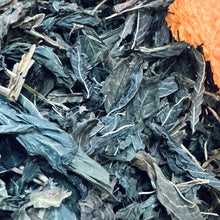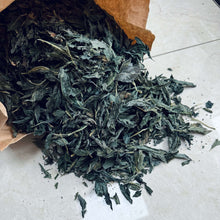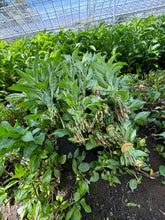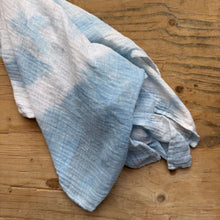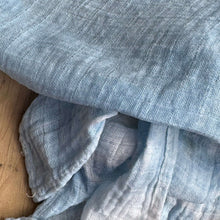NEW ** Persicaria Tinctoria Dry Leaf Indigo.** NEW
Regular price
£28.00
Sale
Dried Indigo Leaf Vat is "a thing”! It is not only Sukumo, Indigo paste or dried Indigo powder which hatch formidable blues, Persicaria Tinctoria Dried Leaf will too.
Having tested the recipe from Liz Spencer, of The Dogwood Dyer with 30g of our dried leaf we were impressed and believe you’ll agree the baby muslin featured here is a pretty shade of indigo blue, from such a small amount of dried leaf indigo.
Our Indigo is harvested into bundles, given a good squeeze prior to being tied to lengths of bamboo, and hung to dry. This all important loving farewell is given to expose the pigment molecule, trapped within the leaf cellulose. Once dried, leaves are stripped and stored in paper sacks and shelved in the dry store.
This recipe is shared by Liz Spencer, with full instruction and notes here eye opening and revolutionary as always, Liz shares with incredible depth the various vat methods of indigo dyeing, underscoring not only the depth of blue achievable from dried leaf but also other colours available from this vat method too.
To start, soak as a rinse leaves in hot water, two or three times. This releases the flavonoid yellow from the leaf. The soak water can be retained for later use too, presenting opportunity for over dyeing indigo. The offerings of colour from dried indigo leaf are spectacular.
To create your vat, fill your dye vessel with warm water dissolving the add calcium hydroxide and potassium carbonate. You’ll need to bring your ingredients to 60°C to allow the leaf to percolate. Just as a traditional vat method the oxidisation of indigo will become obvious on the surface of the vat, with a metallic blue, indicating it is ready.
Ratio of leaf quantities to other ingredients as a base line are as follows.
Per 100g Leaf you will need; 50g Calcium Hydroxide 25g Potassium Carbonate. 25g fructose should you want to start small.
The pigment will be released continuously from the leaf material. Working your fabric with continuous long dips are best from 30 to 40 mins or even over night, as opposed to short dips.
We are offering two sizes of dried leaf;
250g which will give a good range of different shades of indigo and will dye a medium to dark indigo, of up to 500g of fibre or a greater volume of product in a lighter shade.
500g this will give carte blanche to-those wanting to achieve radical shade of dark indigo of the same volume of fibre or fabric and very likely more.
Always remember to scour your pieces well first, to create uniform uptake of colour and maximise penetration deep into fibres for long lasting indigo blue
As always packaging for product is minimal. Dried leaf is shipped in recycled paper sacks,100% compostable, without any plastic, waxes or chemical finishes, minimising consumer waste, once received please keep your goods in a dry space for best results, we recommend glass jars out of direct sunlight as ultimately the best practice.
For comprehensive instruction on various Indigo vat methods be sure to check out The Dogwood Dyer Indigo Vat Tutorial, which includes Dry Leaf Indigo Vat tutorial
Dried Leaf available in two sizes 250g & 500g
Grown, harvested, lovingly hugged & dried in Guernsey, Channel Islands, UK
Required components for this vat
Potassium Carbonate: 75g & 100g
Calcium Hydroxide: 125g & 250g
Fructose: 75g & 150g






